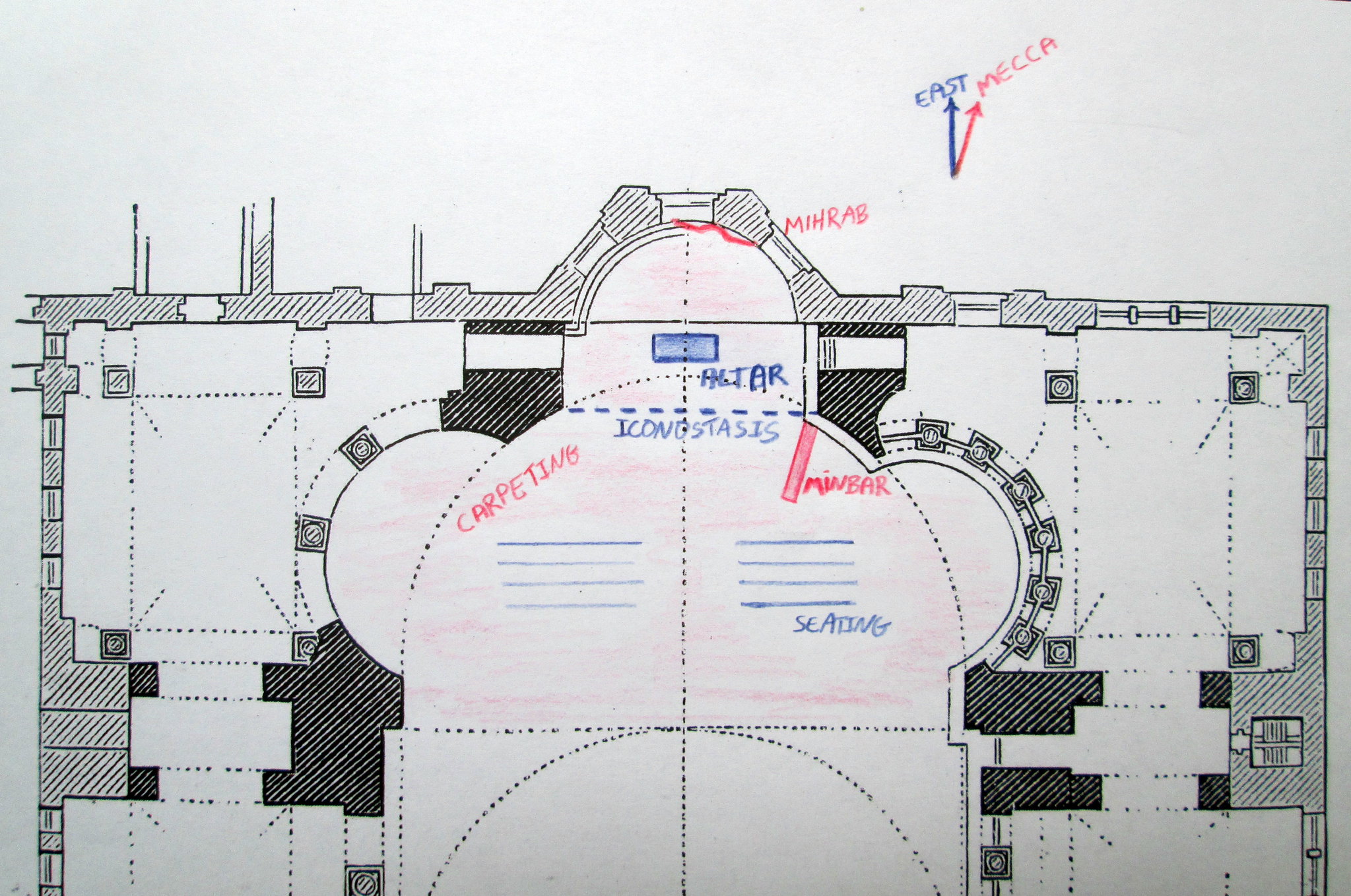Nick Danforth, Georgetown University
While Muslim groups have been the most vocal recently with demands for turning Hagia Sophia / Aya Sofya back into a mosque, Christians too have suggested reconverting it back into a church over the years (in 1953, for example, the US ambassador reported that many Greeks in America had expressed hope the Turkish government would do so "as a grand gesture of thanks" to the Christian world). In addition to publishing goat maps, we here at Afternoon Map are always looking for ways to help reconcile the world's major monotheistic faiths. That's why we're publishing this proposal for converting Hagia Sophia / Aya Sofya back into a mosque and a church. Also, it would remain a museum. The building's magnificent architecture is already well-suited to this arrangement because it retains numerous features from its time as all three. It still has the basic cross shape and numerous mosaics from its time as a church, the minbar, mihrab and minaret from its time as a mosque and the ticket booth and informative plaques from its time as a museum.
While Muslim groups have been the most vocal recently with demands for turning Hagia Sophia / Aya Sofya back into a mosque, Christians too have suggested reconverting it back into a church over the years (in 1953, for example, the US ambassador reported that many Greeks in America had expressed hope the Turkish government would do so "as a grand gesture of thanks" to the Christian world). In addition to publishing goat maps, we here at Afternoon Map are always looking for ways to help reconcile the world's major monotheistic faiths. That's why we're publishing this proposal for converting Hagia Sophia / Aya Sofya back into a mosque and a church. Also, it would remain a museum. The building's magnificent architecture is already well-suited to this arrangement because it retains numerous features from its time as all three. It still has the basic cross shape and numerous mosaics from its time as a church, the minbar, mihrab and minaret from its time as a mosque and the ticket booth and informative plaques from its time as a museum.
So here is the plan: Monday through Thursday its a museum. Friday it's a mosque and Sunday it's a church. When it comes time for prayer on Friday, the building is closed to visitors and opened free of charge to the faithful. The staff spreads out carpets on the floor, everyone takes off their shoes and prays. On Sunday, the staff brings out an alter, an iconostasis, and chairs, then the priest shows up and leads services. Since there are already some large arabic inscriptions hanging from the rafters, the Christians would get to leave some new icons up throughout the week to be fair.
The best part of this plan is that no one can say its ridiculous for a building to be a mosque one day and a church the next, or vice versa, because both sides have already acknowledged the legitimacy of this by asking to convert the building in the first place. If it can go from a mosque to a church or a church to a mosque every five centuries or so, I see no reason it couldn't make the switch on a weekly basis: "For a thousand years are as one day to God, or as a watch in the night." There's also no reason to think the logistics of the transformation should pose a problem either. Accounts of the Ottoman conquest in 1453 invariably state that Fatih entered Hagia Sophia and triumphantly performed namaz. They don't describe any preparatory steps, sweeping or decorative adjustments he performed first; apparently just praying was enough to make the building's transformation into a mosque complete.
More recently, the Hagia Sophia in Iznik was officially converted from a museum into a mosque through the addition of a small raised wooden platform in the center of the large basillica for prayer surrounded by the pre-existing gravel floor from which tourists could see the building's mosaics. Though a Times article quotes many residents worrying that the conversion will discourage Christian visitors, the handful of Christians I've talked to who visited were fairly impressed that the restrained, tasteful conversion enabled the building to continue to function as a museum while being a place of devotion. (looking for the picture to the right just now i discovered that the local Red Crescent president, Mustafa Aydın, apparently originally suggested the Iznik Aya Sofya be opened to Muslims and Christians alike).
Finally, making Hagia Sophia / Aya Sofya a church and a mosque would be entirely in keeping with Ataturk's decision to convert it into a museum. In denying both Muslims and Christians use of the building, I would argue that Ataturk was operating on the same wise logic that has lead generations of parents to tell siblings that if they can't share a toy, neither one of them gets to play with it. Today, members of both faiths have an opportunity to show that they advanced beyond the narrow, confrontational approach to their faiths that made sharing impossible in Ataturk's time.
These days everyone talks a good game when it comes to pluralism and religious tolerance. Here is a chance for them to show they mean it. For pious Muslims and Christians alike who want an opportunity to worship God in a truly transcendent setting, this plan gives them the opportunity to do so. For those on both sides who want to use possession of Hagia Sophia / Aya Sofya as a symbol of religious or national dominance, rejecting this plan gives them a chance to expose themselves as the chauvinists they are.






